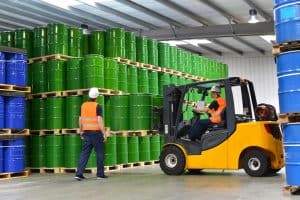This article discusses ways to improve pedestrian safety and address safety challenges related to forklift operation, presented by Bodyguard Safety Solutions.
Forklift usage is crucial in industrial and warehousing operations worldwide. However, they present significant safety risks, particularly to pedestrians within the same work environment. Without proper management, these risks can lead to severe injuries or even death. This blog post aims to raise awareness of forklift safety concerns and offer practical solutions for improving pedestrian safety and reducing collision risks.
Examining the hazards associated with the interaction of forklifts and pedestrians.
Forklifts are powerful machines in the workplace, with their weight and manoeuvring capabilities posing potential risks, particularly to pedestrians. The most common risks include:
- Forklift collisions with pedestrians can result in serious injuries if proper precautions are not taken.
- Forklift operators may encounter visibility challenges, specifically when transporting bulky loads, which can heighten the chances of collisions.
- Excessive speed often contributes to accidents involving forklifts.
- The level of noise in the environment is high.
- High levels of noise may impede pedestrians’ ability to hear warning signals from forklifts, which can lead to accidents.
To improve pedestrian safety, the implementation of the following strategies can be effective in mitigating risks.
Training and re-training for forklift operators and pedestrians are essential. Programs should include safety rules, risk awareness, and emergency response. Operators must know safe speed limits, load handling, and proper communication with pedestrians. Pedestrians need to learn about designated walkways and maintaining distance from operating forklifts.
- Use of Safety Equipment
To improve safety in the workplace, it may be beneficial to outfit forklifts with safety features such as alarms, flashing lights, and rear-view mirrors. Additionally, pedestrians should wear high-visibility clothing to increase their visibility to forklift operators.
- Designated Pedestrian Walkways
It is recommended to create distinct pedestrian paths that are clearly marked, whenever feasible, to keep them separate from forklift operating zones. These specific walkways should remain free of any obstructions.
- Improve Visibility
It is important to have sufficient lighting in areas where forklifts are in operation. It is also recommended to remind operators to use their horns in areas with limited visibility, such as intersections.
- Regular Maintenance
Regular maintenance is necessary for forklifts in order to identify any potential issues.
Identify possible factors that could lead to accidents, such as malfunctions in the brakes or steering.
The system involves advanced electronic control mechanisms.
Electronic controls in forklifts can improve safety by regulating speed, maintaining load balance, and keeping a safe distance from obstacles and pedestrians. Additionally, they can be programmed to reduce speed or stop in specific areas, like pedestrian zones or crosswalks.
Forklifts can have speed limiters installed in areas with high pedestrian traffic, and anti-collision systems can also be implemented using sensors to prevent collisions with objects or people.
The BodyGuard Pedestrian Safety Warning System.
The BodyGuard Pedestrian Safety Warning system is a technological advancement that enhances safety in forklift environments. It employs an innovative approach that creates a safety exclusion zone around the forklift, which serves as a safeguarding perimeter for pedestrians.
The BodyGuard system involves giving pedestrians specialized tags that notify forklift operators when they enter the exclusion zone. This alert system helps operators respond quickly and prevent accidents, reducing associated risks.
The BodyGuard system is known for its adaptability to different work environments (such as warehouse, construction sites and recycling yards) and forklift types. It can be customized to meet the specific needs of each workplace, accommodating their layouts and operational requirements. This flexibility ensures that the system provides effective safety coverage, regardless of the intricacies present in a given workplace setting.
The BodyGuard Pedestrian Safety Warning System can lower the chances of accidents occurring in forklift areas. This technology helps increase pedestrian safety and reduces their exposure to hazards, leading to a safer work environment. By prioritizing safety, the BodyGuard system provides significant support to companies and organizations that use forklift operations.
Conclusion
Incorporating electronic control systems and safety technology like the BodyGuard Pedestrian Safety Warning System can greatly improve pedestrian safety in workplaces with forklifts. It is important for companies to stay aware of advancements in technology to enhance safety, productivity, and operational efficiency. It should be noted that prioritizing safety is not only a legal requirement but also crucial for fostering a favorable and productive work environment.

